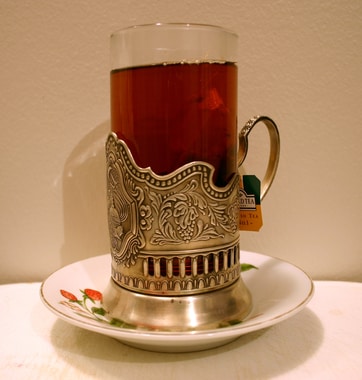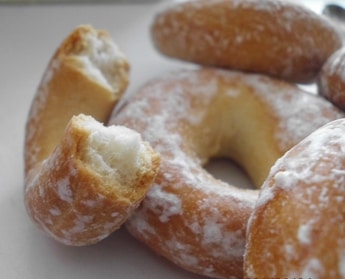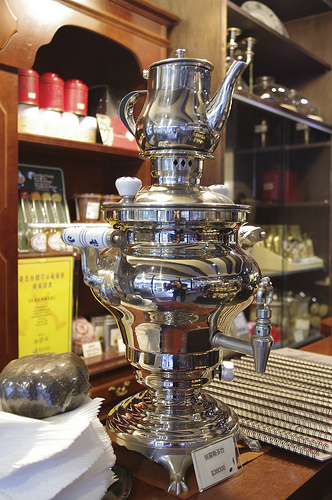Tea is one of the more popular beverages in Russia with the average person drinking over 3 pounds a year! Russians consider it customary to always offer guests tea, and it is polite to accept tea if offered. They even have a saying — having a “sit by the samovar” — to describe tea served with a bit of food or a light meal.
If you’re just interested in how to brew tea Russian style, skip to preparation.
The traditional process of preparing Russian style tea starts with heating water in a metal container called a samovar. When the water is boiling, some of it is transferred into a teacup that sits on top of the Samovar. The water in the teacup is mixed with a large quantity of tea and brewed for an extended period of time. This creates what is referred to as the zavarka tea concentrate.
When the drinker wants to enjoy a cup of tea, they mix some of this tea concentrate with hot water from the samovar. The ratio of zavarka concentrate to water can be adjusted to make the tea stronger or weaker. Since it is served from concentrate, the tea can be enjoyed long after brewing.
Samovars are often held as family heirlooms and can serve as the centerpiece of the dining table. Wealthier families in Russia used to have decorated samovars made of fine metals.

Podstakannik and Glass of Tea – CC
The samovar has a history that predates zavarka brewing and was originally used as an economical way to heat water. Old clay Samovars can be traced back hundreds of years, but the first modern Samovars were first created by the Lisitsyn brothers in Russia in 1778. They are credited with much of the style that exists in metal samovars you see today.
Tea to Use
Preparation
While historical brewing can be fun, most Russians today use electric kettles. If you don’t have an electric kettle, I recommend the Secura as a good general kettle or the Bonavita if you want something high quality. Buying through those links helps support the website. Here is a more modern set of instructions:
- Bring your water to a boil.
- Measure 1 heaping tbsp. of Russian Caravan tea or black tea per cup of tea you want to brew and add it to your teapot. The more tea you use the better.
- Fill your teapot with just enough water to cover the leaves and a bit extra. You want your Zavarka to be concentrated.
- (Optionally) Add some high quality jam, fruit preservative, or other sweetener to your tea.
- Let the tea brew for about 15 minutes. Ideally you want the leaves floating back up to the top of the water.
- Pour the hot water from your electric kettle into your tea cup and add some of the Zavarka concentrate. Adjust the balance of water and Zavarka to your taste.

Powdered Sushki Cookies – CC
Once your tea is ready, make it a proper sit by the samovar with a light snack. The most popular food to eat alongside Russian tea are Sushki cookies: little donut shaped bread rings that are made to be dipped into tea. Russians also serve their tea with food boards such as meat & cheese, or any other type of snack.




